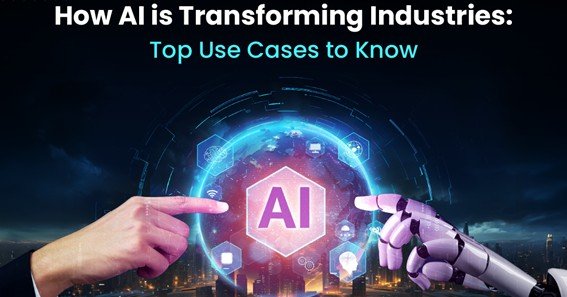From a mere buzzword a few years ago, AI has now become one of the most disruptive technologies, transforming business processes across vertices and industries. From automating tasks to innovating novel solutions, and more, its rising adoption is a testament to its ability.
This article will explore the potential of AI for industry applications. We will discuss the various use cases, the value it brings, challenges, how to get started with it and finally, some good practices to ensure businesses move in the right direction. Let’s jump in!
What is AI?
Artificial Intelligence (AI) means machines doing tasks that need human thinking, like learning and decision-making. AI helps businesses improve by making smarter decisions and saving costs.
Key AI Technologies:
- Machine Learning (ML): Systems learn from data to predict trends and make decisions.
Example: Fraud detection in banks or personalized product suggestions in e-commerce. - Natural Language Processing (NLP): NLP helps machines understand human language.
Example: AI chatbots answering customer questions or translating languages. - Computer Vision: Machines “see” images or videos to detect objects or analyze patterns. Example: Healthcare uses AI to read medical images for faster diagnosis.
Top AI Use Cases Across Industries
Let’s take an overview of the possibilities of AI for real-world industry use. These will give you an idea as to what is possible with the current AI technology.
1. AI in Healthcare
- Predictive Diagnostics: AI tools analyze medical data to predict diseases early. Example: Detecting cancer signs with high accuracy in radiology scans.
- Virtual Assistants: AI chatbots can schedule appointments, provide answers, and manage post-treatment care based on the patient’s history.
- Drug Discovery: Machine learning speeds up finding effective drugs, saving time and costs. Example: IBM Watson Health helps doctors make accurate diagnoses using large medical datasets.
2. AI in Finance
- Fraud Detection: AI can pick out unusual transaction patterns to prevent fraud.
- Algorithmic Trading: AI analyzes market trends and executes trades faster than humans.
- Chatbots: AI automates customer support, answering inquiries quickly. Example: JPMorgan Chase uses AI to detect fraud and protect customer accounts.
3. AI in Retail
- Personalized Recommendations: AI suggests products based on user behavior, boosting sales.
- Inventory Management: AI forecasts demand to reduce overstock and shortages.
- Virtual Shopping: AI powers virtual try-ons and augmented reality experiences.
Example: Amazon uses AI to recommend products, driving significant sales.
4. AI in Entertainment and Media
- Content Personalization: Streaming platforms like Netflix use AI to recommend content tailored to user preferences.
- AI-Generated Content: AI creates gaming levels, characters, and immersive virtual experiences.
- Sentiment Analysis: AI gauges audience reactions and improves marketing strategies.
Example: Netflix’s recommendation system drives engagement by suggesting shows based on user behavior.
5. AI in Transportation and Logistics
- Route Optimization: AI can find the most efficient delivery routes by analyzing traffic, weather, and road conditions. This helps cut costs, save time, and lower emissions.
- Autonomous Vehicles and Drones: AI-powered self-driving trucks and drones are game changers. They improve delivery speeds, reduce labor costs, and enhance supply chains. Drones are particularly useful for last-mile deliveries.
- Inventory Tracking: AI enhances supply chain management with real-time tracking and demand forecasting. This reduces stock issues and improves efficiency. Example: UPS uses AI to optimize delivery routes, saving millions annually by reducing fuel costs and improving service.
6. AI in Energy and Utilities
- Predictive Analytics: AI can forecast energy demands. This helps manage resources efficiently and reduces waste.
- Smart Grids: AI-powered grids balance supply and demand in real-time. This minimizes outages and integrates renewables.
- Renewable Energy Optimization: AI can predict power output from solar and wind farms. This improves efficiency and reliability. Example: AI helps solar farms forecast energy production, boosting efficiency and sustainability.
7. AI in Education
- Personalized Learning: AI can curate lessons to each student’s needs. Further, it can track progress and dynamically adjust content for better learning.
- Automated Grading: AI can drastically speed up grading for tests and assignments. This saves teachers time.
- Virtual Tutors: AI-powered tutors can provide 24/7 assistance. This helps students understand tough topics and stay engaged. Example: Duolingo uses AI to personalize language lessons, offering real-time feedback to learners.
8. AI in Manufacturing
- Predictive Maintenance: AI monitors machines to avoid costly breakdowns by scheduling timely maintenance.
- Quality Control: AI detects product defects using computer vision.
- Automation: AI-driven robots increase production speed and accuracy.
Example: Siemens uses AI to reduce equipment downtime and improve efficiency.
9. AI in Software Development
- Code generation and Debugging – AI-driven tools can complete code and test prototypes faster than manual testing.
- Personalization in Software – AI is extensively used in mobile apps to bring a personal touch. They recommend products, content, and experiences based on the user’s taste.
- Faster Time to Market – With AI assisting at every stage of development, software development is faster. This allows businesses to prototype and iterate better.
AI applications are transforming industries, offering businesses smarter, faster solutions.
How AI Is Transforming Industries?
Now, let’s look at the various ways AI is enhancing different industries and processes. Through indicative examples, we will understand its utilities.
1. Enhanced Efficiency and Productivity – AI can automate repetitive tasks. This saves time and reduces errors. Employees can focus on complex work, increasing overall productivity.
- Automation: AI can do tasks like data entry, scheduling, and customer queries with great efficiency. Thus, it ensures better resource utilization.
- Example: AI chatbots manage routine customer inquiries 24/7, improving efficiency and freeing up staff for advanced issues.
2. Improved Decision-Making – AI can process large datasets to provide actionable insights and deeper analysis. This helps businesses make smarter decisions using advanced data analytics.
- Data Insights: AI can find patterns and forecast trends to finetune strategies.
- Example: Investment firms use AI to predict market trends and assess risks, enabling faster, data-driven decisions.
3. Cost Reduction – AI reduces costs by optimizing workflows and preventing inefficiencies. This is crucial for industries like manufacturing and healthcare.
- Predictive Maintenance: AI monitors equipment, predicting failures to avoid expensive repairs and downtime.
- Example: In factories, AI alerts managers about potential machine wear, saving repair costs and boosting productivity.
4. Better Customer Experiences – AI enhances customer interactions by personalizing services and recommendations.
- Personalization: AI analyzes customer data to deliver tailored suggestions.
- Example: Retailers like Amazon use AI to recommend products, increasing satisfaction and loyalty.
AI applications across industries offer smarter, faster solutions, revolutionizing business processes and customer engagement.
Challenges in AI Adoption
AI is a radical technology. Thus, its adoption requires thoughtful planning and execution for smoother integration. Without expert help, AI adoption can feel superficial.
1. Data Privacy and Security – AI systems rely on large datasets, including sensitive information. Poor data handling can lead to breaches, financial losses, and reputation damage.
- Risks: AI systems are vulnerable to hacking and unauthorized access due to their reliance on big data. For example, AI chatbots used in customer service could expose sensitive details if breached.
- Solutions: Businesses can use encryption to protect data and comply with regulations like GDPR or CCPA to ensure safe handling of customer information.
2. Lack of Expertise – There’s a shortage of skilled professionals in AI, slowing its adoption.
- Impact: Companies without the right talent may struggle with inefficient systems or failed AI projects. Small businesses often outsource, adding costs but limiting control.
- Example: Many firms depend on third-party vendors for AI solutions due to this talent gap.
3. Ethical Concerns – Bias in AI systems is a major issue, especially in areas like hiring or lending.
- Bias Risks: Poor datasets lead to unfair outcomes, like facial recognition errors with higher failure rates for certain groups.
- Example: AI hiring tools can favor male candidates if trained on biased historical data.
- Solutions: Use diverse datasets, monitor systems, and ensure transparency in AI decisions.
4. High Costs – AI adoption is expensive, making it tough for smaller businesses.
- Initial Costs: Setting up AI infrastructure and hiring talent require significant investment.
- Ongoing Costs: Regular training, updates, and compliance add to long-term expenses.
AI offers solutions for businesses but comes with challenges that need thoughtful handling.
How to Start Using AI for Your Business?
1. Find the Right Areas for AI – Start by identifying pain points where AI can help.
- Automate Repetitive Tasks: Use AI for customer service, data entry, or inventory management.
- Data-Driven Insights: AI can analyze customer behavior, predict trends, or optimize supply chains.
- Improve Efficiency: AI applications across industries show how businesses save time and cost with automation.
2. Work with AI Experts – Bringing in experts ensures the right approach. They help with strategy and setup.
- Get Guidance: Availing dedicated AI/ML development services is recommended. It will help overcome challenges and bring expert guidance. Further, it ensures deeper integration with your current processes for better results.
- Custom Solutions: Create a tailored AI plan that fits your goals, current tech, and measures success with clear KPIs.
3. Train Your Team – Equip your staff to manage and use AI effectively.
- Upskill Employees: Provide AI training or online courses to build skills.
- Encourage Growth: Stay updated with evolving AI trends by attending workshops or conferences.
4. Start Small and Test – Test AI solutions with pilot projects.
- Run Small Trials: Focus on one area where AI can bring quick, measurable results.
- Learn and Expand: Use feedback to improve before scaling up AI use cases for businesses.
AI solutions for business can transform operations when applied thoughtfully and strategically. Start small, and scale as you see results.
Future Trends in AI Across Industries
Given AI is improving at a rapid pace, it is crucial to have some context for the future. This will allow for a long-term integration.
1. AI-Powered Sustainability – AI is helping industries improve sustainability by reducing waste and optimizing resources.
- Energy Optimization: AI in business applications like smart buildings adjusts lighting and cooling based on usage, cutting energy costs. In manufacturing, it identifies inefficiencies to minimize consumption.
- Waste Reduction: AI use cases in industries like agriculture predict crop needs, reducing water waste and pesticide use. In logistics, AI helps balance supply and demand to lower overproduction.
- Combating Climate Change: AI applications across industries monitor deforestation and climate shifts through satellite data, aiding in environmental policies.
2. AI and Edge Computing – AI and edge computing are improving real-time decision-making and IoT systems.
- Real-Time Insights: AI solutions for businesses like autonomous vehicles process data instantly for critical decisions.
- Enhanced IoT Devices: AI in devices enables real-time health monitoring or industrial automation, reducing reliance on cloud computing.
- Cost Efficiency: AI at the edge reduces bandwidth costs by processing data locally.
3. AI for Human Augmentation – AI is enhancing human capabilities rather than replacing them.
- In Medicine: AI models improve diagnostics and enable personalized treatments.
- In Design: AI tools generate ideas and optimize designs for engineers.
- In Work: AI-powered chatbots assist businesses, handling routine tasks efficiently.
4. Generative AI Growth – AI is transforming creative industries.
- Content Creation: Tools generate marketing materials, music, or art at scale.
- Personalization: AI adapts media content for user preferences, driving engagement.
AI is transforming industries with these advancements, shaping a smarter future.
Conclusion
From automating tasks to driving innovation, AI is certainly a powerful technology that needs serious consideration. Its potential is only limited by your imagination. However, a fair analysis of your business is required to understand how and in what capacity you should integrate Gen AI.
If you lack the expertise, onboarding consultants or availing similar services from a dedicated company can help bring guidance and thoughtful strategy for a seamless integration that actually enhances your business. Finally, don’t overlook the ethical concerns and regulatory measures in lieu of first-movers advantage.










